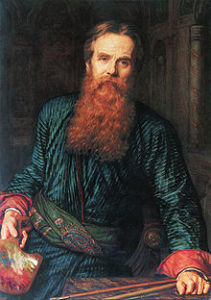William Holman Hunt was a member of the Pre Raphaelite Brotherhood. Sounds funky, huh? The Brotherhood was a group of English painters founded in 1848. More about their unique vision below.
They were known for paintings filled with allegory and mythology; and they were much into nature and detail… lots of detail.
The Pre Raphaelites derived their name from their desire to create art that held the qualities of Renaissance art before the time of the great painter Raphael. I’ve always wondered if they wanted to include Raphael in their reference period, or were essentially saying, “Raphael really messed things up.” There were hand handful of painters in the group, and they had all kinds of principles and doctrines around which they made their art. They were inspired by nature, mythology and history (and pretty girls). Their paintings very often carried messages – moral, symbolic, allegorical or otherwise.
• What, When, Who, Where:
Our English Coasts, 1852 (Strayed Sheep) (1852)
William Holman Hunt
English
1′ 5″ x 1′ 11″ (43 cm x 58 cm)<– quite small for such a vast landscape!
- Here’s a nice Kahn Academy video piece on this painting.
- Here’s an image link on Google Art Project that will enable you to zoom in, in this case to actual size!
Image Source: Wikimedia Commons
• What’s Cool About It:

First of all, it’s a beautifully painted piece. The amazing detail and light. That green pasture below looks very inviting. You really just want to jump into this thing and walk in the sun. I was surprised to find out how small it is! I expected a big whopping canvas. Holman Hunt has really shoved a big world into this little piece.
But, there’s a lot more going on. Given the PRB’s predilection for allegory, we’ve got to figure there’s a message here. Holman Hunt never spelled it out exactly, but here’s what’s clear:
- The title, “Our English Coasts, 1852,” is a pretty specific reference to an important debate at the time: Was England safe from invasion?
- These innocent sheep are wandering perilously close to the dangerous cliffs. Who’s looking after them? A couple of those sheep are caught in the brambles, seemingly unaware of their situation. In a way, it’s like saying: “People of England! Do you realize you are in peril!”
- There could also be other implications: A strayed flock often implies people that have gone morally or civically astray.
- We can see the English Channel clearly, and France is just out of view on the horizon. In fact, this particular area near Hastings is where England was monumentally invaded by the Normans in 1066.
So… this beautiful pastoral scene carries a warning of sorts: Look after the flock.
• Behind the Scenes:
The PRB was partly a reaction against the art establishment of the time – The Royal Academy of Art. Though Hunt was enrolled in the Academy, he desired to revitalize art with detailed observation of nature in combination with “a spirit of quasi-religious devotion to truth.” (Wikipedia).

• Fun Fact:
Some of those sheep have red marks on their backs. That is dye, and it was (still is) a common technique to differentiate the ownership of the sheep. Mr. Red Stripe has not been tending his flock well.





